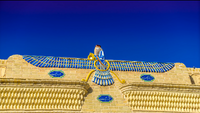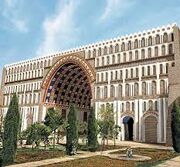| Imperial State of Persia 𐭣𐭥𐭩𐭲𐭥𐭧 𐭫𐭥 𐭣𐭧𐭥𐭲𐭭𐭩𐭪 𐭥𐭫𐭥𐭬𐭭𐭲𐭩𐭪𐭫𐭲𐭥𐭩 (Persian) Timeline: Differently | ||||||
|---|---|---|---|---|---|---|
|
||||||
| Motto: 𐭠𐭭𐭩𐭪𐭰𐭥𐭬 𐭧𐭬𐭥𐭫𐭰 𐭨𐭭𐭢𐭥𐭫𐭰، 𐭤𐭬𐭲𐭥𐭫𐭰 𐭫𐭲𐭭 𐭩𐭬𐭢𐭥𐭫𐭰 "Good Thoughts, Good Words, Good Deeds" |
||||||
| Anthem: 𐭮𐭧𐭥𐭯𐭲𐭠 𐭱𐭩𐭥𐭠! Salamatih Shah! (Vatanam) |
||||||
| Location of West Persia (green)
|
||||||
| Capital (and largest city) | Ctesiphon | |||||
| Official languages | Persian | |||||
| Religion | Zoroastrianism (official) Manichaeism |
|||||
| Government | Federal parliamentary constitutional monarchy | |||||
| - | Monarch | Yazdegerd II | ||||
| - | Prime Minister | Hassan Rouhani | ||||
| Independence from the Second Sassanid Empire | ||||||
| - | Split | 18 October 1712 | ||||
| - | Transition into imperial state | 19 May 1951 | ||||
| Area | ||||||
| - | Total | 2,245,226 km2 866,887 sq mi |
||||
| Population | ||||||
| - | Estimate | 152,320,687 (7th) | ||||
| Currency | West Persian rial | |||||
| Drives on the | right | |||||
West Persia (Persian: 𐭣𐭧𐭥𐭠𐭩 𐭥𐭫𐭫𐭥𐭰𐭧), officially the Imperial State of Persia (Persian: 𐭣𐭥𐭩𐭲𐭥𐭧 𐭫𐭥 𐭣𐭧𐭥𐭲𐭭𐭩𐭪 𐭥𐭫𐭥𐭬𐭭𐭲𐭩𐭪𐭫𐭲𐭥𐭩), is a country in the Middle East. It borders Syria Palaestina and Rhomania to the west, Georgia, Armenia and Azerbaijan to the northwest, Uzbekistan to the northeast, East Persia to the east and Arabia to the southwest. It is bounded by the Caspian Sea on the north, the Gulf of Aden on the south, and the Black Sea on the northwest. The capital and largest city is Ctesiphon.
With a population of over 152 million inhabitants, West Persia is the fourth-most populous country in Asia and the seventh in the world. Its surface area of 2.2 million square kilometers makes it the sixth-largest country in Asia and the 18th-largest in the world.
Officially a Zoroastrian country, West Persia is known for its religious and civil traditions. It has a high weekly attendance to fire temples and is considered by many the modern successor of the Achaemenid and Sassanid empires.
History[]
Empire of West Persia (1712-1951)[]
The modern states of West and East Persia formed in 1712, with the split of the Second Sassanid Empire, a government under which they were united until then. Although that division was motivated mostly by administrative problems, the two new Persias ended up taking very different political, social, and cultural paths in the following centuries. While the east became increasingly secular and populist, eventually falling to a socialist regime in the 1920s, the west remained a very conservative and religious society, and continued the Sassanid legacy as the Empire of West Persia, also known as "Third Sassanid Empire".
West Persia's absolute monarchy system was abolished in 1790 when the Shah's powers were reduced and a much more democratic and decentralized constitutional monarchy was established. This form of government stayed the same until 1951. In 1951, the popular Shah Khosrau IV took over control by abolishing the post of Prime Minister and becoming an absolute monarch. The Shah then established what he called "The Imperial State of Persia", though it is still called West Persia. This period is also referred to as the "Fourth Sassanid Empire".
Blood Revolution (1977-1978)[]
Although Emperor Khosrau IV led many liberal reforms, to the point where West Persia became a country with the highest civil liberties in the Middle East region, he was unable to rid himself of the powerful nobility. In 1977, one of the Shah's kinsman, Hakhamanish Pahlavi staged a protest march which soon developed to call for the abolition of the monarchy. The Shah ordered the arrests of dissidents and this resulted in violent clashes between the protesters and the police. These violent protests would often lead to a lot of bloodshed, and the uprising came to be known as the Blood Revolution. Protesters claimed "The Shah has blood on his hands". In 1978, after West Persia was on the brink of civil war, Khosrau sat down to negotiate a deal with the republicans. This resulted in the Constitution of 1979, which ended the Fourth Sassanid Empire and established the Fifth Sassanid Empire.
War with Armenia (1975-1980)[]
Fifth Sassanid Empire (1979-present)[]
The Constitution of 1979 established a power-sharing agreement between The Shah, the nobility, and the common gentry of West Persia. The Shah would hold the power of veto as well as other executive authority (such as executive orders, commutation or pardoning of sentences, declaration of war), while the country would have an elected Prime Minister who would lead the legislative affairs of the country. The common gentry would be represented in the House of Commons, the house from which the Prime Minister would originate. The nobility would be represented in the Senate, with commoners being introduced upon their induction into the nobility. The Senate was determined to act as an advisory council to the Shah and would vote to confirm/reject the Shah's nominees for ambassadorial appointments. The appropriations were handed to the nobility, however if two-thirds of the House of Commons votes to reject an appropriation by the Senate, then the power to appropriations would shift to the House of Commons for the said appropriation.
While there has been an uneasy cooperation between civil society and the West Persian monarchy, many in the country still resent the monarchy and blame it for many of the country's ongoing woes such as income inequality and wealth disparities between ethnic Iranians and non-Iranian minorities within the country. A 2021 poll found that only 43% of West Persians support the monarchy in any capacity, down from 60% in a poll conducted twenty years earlier.
Religion[]

A sumptuous fire temple in Tehran. This is a very typical sight in West Persia.
About 55% of West Persians are adepts of the ancient religion of Zoroastrianism, which has official status as the state religion due to its very long history and profound impact on the life of most citizens. The second-largest religion is Manichaeism, with 40% of adepts. Since the Constitution also guarantees absolute freedom of religion, minority faiths are also practiced in the country, notably Christian Orthodoxy (5%) and Sunni Islam (4%). The irreligious (such as atheists and agnostics) also constitute a significant minority, although their exact numbers are unknown.
Politics[]

Yazdegerd II, the current Shah of West Persia
West Persia is a constitutional monarchy in which the power of the monarch, called the Shah, is limited to a ceremonial role, with executive power similar to other democratic heads of states. He is defined in the Constitution as "the symbol of the State, the People and the Religion". Legislative power is wielded by the Prime Minister of West Persia and his democratically-elected Cabinet heads executive departments, whose sovereignty is officially vested in the people. The parliament is bicameral, with the Upper House (Senate) having no maximum number of seats; there are currently 316 Senators and the Lower House having 465 seats.

The Imperial Palace, Ctesiphon
The Capital of West Persia is the ancient city of Ctesiphon. Ctesiphon was founded in the late 120s BC. The city became the Empire's capital circa 58 BC during the reign of Orodes II. Gradually, the city merged with the old Hellenistic capital of Seleucia and other nearby settlements to form a cosmopolitan metropolis. The city was the glamorous center of the Second Sasanian Empire, which flourished in culture and arts. However, during the Perso-British War, the City was captured by British forces and sacked. The Imperial Palace, with one of the oldest intact arches in History was burned, and half of the city was reduced to ash. However, the city was rebuilt after the war, but it never recovered it's medieval glory.
Senate[]
The West Persian Senate is an unelected chamber, which represents the nobility of West Persia. These members belong to noble families and inherit their seats in the Senate (either through merit or through birth). Until 2017, a Senator served for life, however with the passage of the Parliamentary Reform Act, 2017, which Shah Yazdegerd II signed into effect, a hereditary Senator can only serve for a maximum of twenty-five years or up to the age of seventy-five, whichever comes first. Retired Senators are still allowed on the floor but do not have a vote. They do however comprise of the Senate Advisory Council, where they are influential and can have a sway over a certain bill.
The West Persian Senate is also responsible for approving the ambassadorial nominations provided by the Shah (who is in-charge of foreign relations). The Senate also oversees appropriation for government funding. The Senate is known to be a strong body and can issue subpoenas if members of the public refuse to testify in front of the Senate (the House of Commons also does testifying but does not have the power to subpoena; and in such cases asks the Senate to issue one). The Senate can vote to reject a bill passed in the House of Commons. The Speaker of the House of Commons can then send the bill to the Emperor with a rejection plea (which seeks to overturn the Senate vote). If the Emperor accepts the rejection plea, the bill is granted royal assent and signed. If the Emperor rejects the rejection plea, the bill goes back to parliament where the House of Commons leaders can sit with Senate leaders to negotiate amendments on the bill. This power was established to ensure that the nobility did not overpower the commoners.
| ||||||||||||||||||





